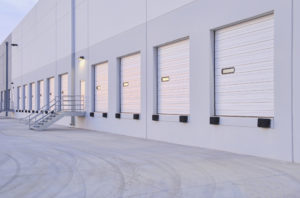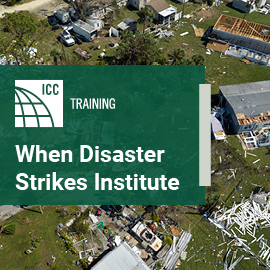
High-speed doors and egress
In designing a path of egress for a building, there may be instances in which a high-speed door becomes a component of the path. This article explains how high-speed doors can be used as a means of egress, or exit, by describing options, code guidance and specification guidance.
What is a high-speed door?
A high-speed door is a non-swinging door with a minimum opening rate of 32 inches per second, a minimum closing rate of 24 inches per second, and a means to automatically reclose the door. These doors typically act in a rolling, folding or sliding manner.
High-speed door construction
High-speed doors are typically non-fire-rated and thus should only be used in walls that are also non-fire-rated. High-speed door panels and curtains can be made from rubber, fabric, vinyl, composites, aluminum or steel.
Where do you typically see high-speed doors?
High-speed doors are most commonly used in factories and in institutional, mercantile and storage buildings where environmental separation, energy efficiency, and/or security are required. They are not generally used in public assembly, educational, high-hazard, residential and utility/miscellaneous occupancies. When used as a component of egress, high-speed doors can accommodate motorized equipment, traffic and pedestrians.
What is egress?
The International Building Code (IBC) defines “means of egress” as “a continuous and unobstructed path of vertical and horizontal egress travel from any occupied portion of a building or structure to a public way.”
NFPA 101, known as Life Safety Code, defines “means of egress” similarly as “a continuous and unobstructed way of travel from any point in a building or structure to a public way.” Both the IBC and NFPA 101 describe a means of egress as consisting of three separate and distinct parts: the exit access, the exit and the exit discharge.
Situations requiring egress
Generally, emergency situations in which occupants need to evacuate a building require a means of egress. For example, fires and/or hazardous conditions that can jeopardize the health, safety, and/or welfare of building occupants require a safe path for egress.
High-speed door egress options
When installing a high-speed door as a component of a required means of egress, the Door & Access Systems Manufacturers Association recommends that at least one of the following options be employed:
1. Manual operation through door counterbalancing: The door should be easy to open from either side of the opening without special knowledge or effort. The force required to operate or set the door in motion should not exceed 30 pounds and should not exceed 15 pounds to open the door to the minimum required height and width for egress. Manual operation can include chain hoist, crank, or gripping points.
2. Breakout panels: The door panels should be easy to break out manually in the event of power failure. The force required to break out the door panels should not exceed 30 pounds, and the force required to push open the door panels to the minimum height and width for each egress opening should not exceed 15 pounds.
3. Backup power supply: The door assembly should have an integrated standby power supply and be electrically monitored. The door assembly should open to a minimum height of 80 inches and a minimum width of 32 inches, within 10 seconds after activation. It should stay open until full power is resumed. A backup power supply as a stand-alone option is subject to approval.
All parameters and requirements are outlined in IBC Section 1010.1.4.3 titled “special purpose horizontal sliding, accordion or folding doors.”
Guidelines when choosing an egress option
If one of the three egress options is applied, reasoning must be provided. Occupancy type, space, door type, material and doorway design should be referenced.
To be exempt from the rating requirements in the IBC and NFPA 101, the architect, engineer, designer or building owner must prove that the high-speed door is not fire-rated and that it is being installed in a non-fire-rated wall.
International Building Code content
The IBC does not address high-speed doors specifically. However, there are sections within the IBC that can be applied to high-speed door installations requiring egress. A code official, using the IBC as reference, would need to review the section data and information applied.
To demonstrate compliance with the IBC, code content that could be used by interpretation and application would need to be cited.
In IBC Section 1010.1.2, Exception 1 allows non-pivoting, and rolling, folding and sliding high-speed doors to be used for egress in private garages, office areas, and factory and storage areas. This is only allowed when there are 10 occupants or less at the location.
If a code official determines this exception is not applicable, they could invoke Section 104.11, titled “Alternative materials, design, and methods of construction and equipment.” Based on this content, the high-speed door is classified as an “alternative design”.
Otherwise, content most likely to be used is found in Section 1010.1.4.3, which is titled and intended for “special purpose horizontal sliding, accordion or folding doors”.
There are additional provisions outlined in Section 104.11 that could also be applied. This section specifies that approval can be obtained when the building official finds that the design complies with the intent of the code and is not less than the equivalent in quality, strength, effectiveness, fire resistance, durability and safety.
For high-speed doors used as a component of egress, the equivalency to a conventionally operating door would likely be measured in terms of quality, strength, effectiveness, durability and safety. When the occupancy load exceeds 10, the use of a high-speed door as a component of a means of egress will be at the discretion of the authority having jurisdiction.
Steps to remember
For a high-speed door to be an egress component, architects, engineers, designers and building owners should do the following:
• Confirm that a high-speed door is needed at the location.
• Distinguish the type(s) of egress design.
• Consider the users of the door from within the building (private versus public) and provide necessary signage.
• Ensure that the door is a usable door.
• Include all relevant “entrapment protection” devices, which includes any device protecting people from being caught under a closing door.
Conclusion
High-speed doors serve a valuable and important function in a building. The size and speed of these doors would allow a large amount of people to exit a building quickly and could potentially save many lives.
Note: Content from this article can be found in DASMA Technical Data Sheet #458, available for free at www.dasma.com.









